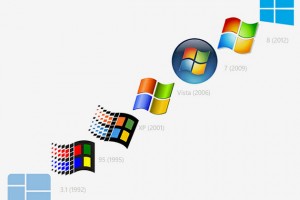Microsoft Window Operating System

MS Window was introduced by Microsoft Corporation in the year 1985. It was brought in as an odd on to MS-Dos due to growing interest of users in GUI’s. The first version of MS Window is 1.0, released in 1985.It did not provide a complete system, rather it provide an extended version of MS-DOS. After this window1.90, window 3.0 was released. After success of window 3.0, Microsoft come up with several new version of window OS. Some are given below:
Window 95: released in august 24, 1995
New features:
- plug and play
- 32-bit OS
- Registry
- Right mouse click
Window 98: released in June 1998
New features:
- improved protection through backup
- Improved data supports (supports new devices such as DVD, USB)
- Internet Explorer
- Customizable Taskbar
Window 2000: released in February 2000
New features:
- protect memory of individual application and processes to
- that failure of a single application cannot bring the system down
- Includes greater supports for high speed networking devices such as cable modems & native ATM.
- Supports NTFS along with the supports for both FAT16 & FAT32.
Window XP: released in October 2001
It is mainly used on general purpose computer system. The letter ‘XP’ in Window XP stands for
Experience. Window XP is the first consumer oriented OS. That is built on the Window NT Kernel & architecture by Microsoft. The most common edition of Window XP are the Window XP Home EDITION AND Window XP Professional.
Window Vista: released in 2007. It was upgraded version of window XP and Window 2000
New features:
- New multimedia creation tools such as DVD Maker.
- Ability to automatically detect and correct problems that are encountered on the computer
- A completely new GUI & Visual style known as Window Aero.
- Improved searching features that provides instant search available through all explorers Window.
Programming Environment:
A programming Environment comprises all those components that facilitate the development of a program. These components are largely divided in two categories:
- Programming tools
- Application programming interface
Programming tool:
The software application which used for the development maintenance and debugging of a software program is known as programming tools some of programming tools
Some of programming tools are:
- Integrated Development Environment (IDE): It is the most commonly used tool that offers on an integrated environment to the programmer for the software development. It contains compiler, editor, and debugger. Etc
- Debugging tool: It is a special tool that helps the programmer to detect and removes bugs or errors from a program.
- Memory usage tools: It helps the programmer to manage the memory resources in an efficient manner
Application programming interface (API’s):
An API can be defined as a collection of data structures, classes, protocols, and predefined function stored in the form of libraries these libraries are included in the software package of the programming language like c, c++ etc. An API makes the development task easier for the programmer as a in-built API components are used again and again ensuring reusability
